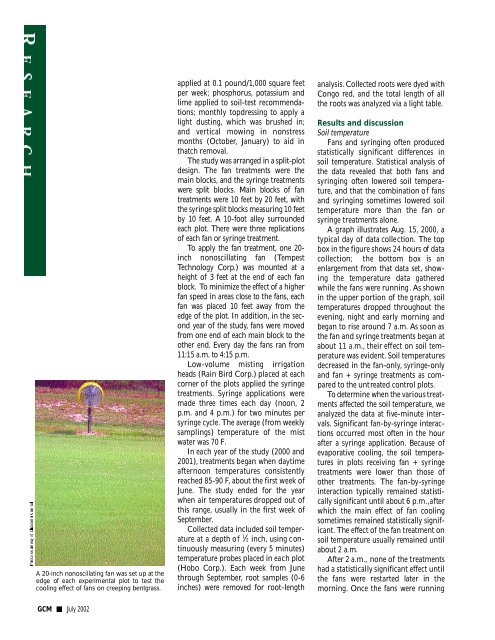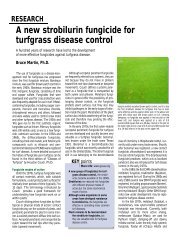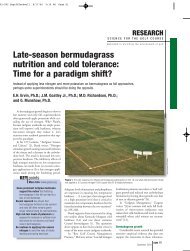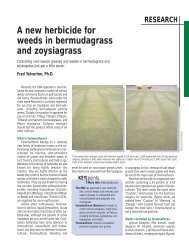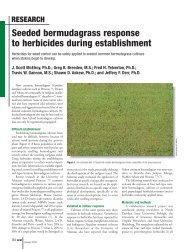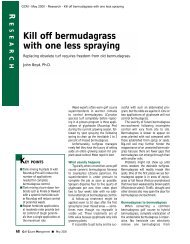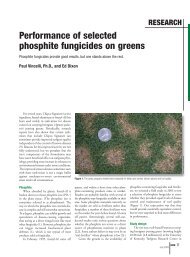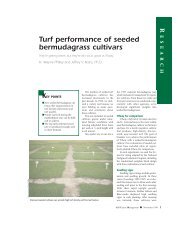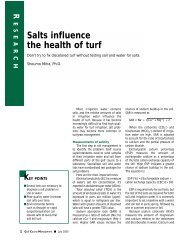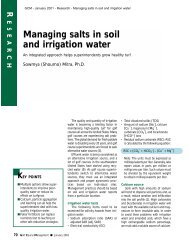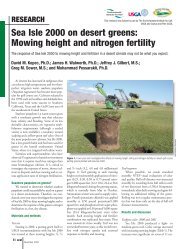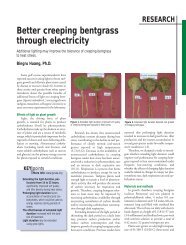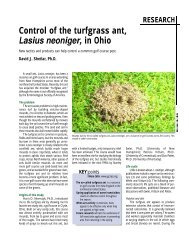Fans and syringing for cooling creeping bentgrass putting ... - GCSAA
Fans and syringing for cooling creeping bentgrass putting ... - GCSAA
Fans and syringing for cooling creeping bentgrass putting ... - GCSAA
You also want an ePaper? Increase the reach of your titles
YUMPU automatically turns print PDFs into web optimized ePapers that Google loves.
A 20-inch nonoscillating fan was set up at theedge of each experimental plot to test the<strong>cooling</strong> effect of fans on <strong>creeping</strong> bentgr a s s .applied at 0.1 pound/1,000 square feetper week; phosphorus, potassium <strong>and</strong>lime applied to soil-test recommendations;monthly topdressing to apply alight dusting, which was brushed in;<strong>and</strong> vertical mowing in non s tre s smonths (October, January) to aid inthatch removal.The stu dy was arra n ged in a split-plotde s i gn . The fan tre a tm ents were themain bl ock s , <strong>and</strong> the syri n ge tre a tm en t swere split bl ock s . Main bl ocks of f a ntre a tm ents were 10 feet by 20 feet , wi t hthe syri n ge split bl ocks measu ring 10 feetby 10 feet . A 10-foot all ey su rro u n dede ach plot. Th ere were three rep l i c a ti on sof e ach fan or syri n ge tre a tm en t .To app ly the fan tre a tm en t ,one 20-i n ch non o s c i ll a ting fan (Tem pe s tTech n o l ogy Corp.) was mounted at ah ei ght of 3 feet at the end of e ach fanbl ock . To minimize the ef fect of a high erfan speed in areas close to the fans, e achfan was placed 10 feet aw ay from theed ge of the plot. In ad d i ti on ,in the secondyear of the stu dy, fans were movedf rom one end of e ach main bl ock to theo t h er en d . Every day the fans ran from11:15 a.m. to 4:15 p. m .Low - vo lume misting irri ga ti onheads (Rain Bird Corp.) placed at eachcorner of the plots applied the syringetreatments. Syringe applications weremade three times each day (noon, 2p.m. <strong>and</strong> 4 p.m.) <strong>for</strong> two minutes persyringe cycle. The average (from weeklys a m p l i n gs ) tem pera tu re of the mistwater was 70 F.In each year of the study (2000 <strong>and</strong>2001), treatments began when daytimea f tern oon tem pera tu res con s i s ten t lyreached 85-90 F, about the first week ofJune. The study ended <strong>for</strong> the yearwhen air temperatures dropped out ofthis range, usually in the first week ofSeptember.Collected data included soil temperatureat a depth of 1 ⁄2 inch, using continuouslymeasuring (every 5 minutes)temperature probes placed in each plot(Hobo Corp.). Each week from Junethrough September, root samples (0-6inches) were removed <strong>for</strong> root-lengthanalysis. Collected roots were dyed withCongo red, <strong>and</strong> the total length of allthe roots was analyzed via a light table.Results <strong>and</strong> discussionSoil temperature<strong>Fans</strong> <strong>and</strong> <strong>syringing</strong> often produceds t a ti s ti c a lly s i gnificant differen ces insoil temperature. Statistical analysis ofthe data revealed that both fans <strong>and</strong><strong>syringing</strong> often lowered soil temperature,<strong>and</strong> that the combination of fans<strong>and</strong> <strong>syringing</strong> sometimes lowered soiltem pera tu re more than the fan orsyringe treatments alone.A graph illustrates Aug. 15, 2000, atypical day of data collection. The topbox in the figure shows 24 hours of dataco ll ecti on ; the bo t tom box is anenlargement from that data set, showingthe tem pera tu re data ga t h eredwhile the fans were running. As shownin the upper portion of the graph, soiltemperatures dropped throughout theevening, night <strong>and</strong> early morning <strong>and</strong>began to rise around 7 a.m. As soon asthe fan <strong>and</strong> syringe treatments began atabout 11 a.m., their effect on soil temperaturewas evident. Soil temperaturesdecreased in the fan-only, syringe-only<strong>and</strong> fan + syringe treatments as comparedto the untreated control plots.To determine wh en the va rious tre a t-m ents affected the soil tem pera tu re , wea n a ly zed the data at five - m i nute interval s . Si gnificant fan-by - s yri n ge interactions occ u rred most of ten in the houra f ter a syri n ge app l i c a ti on . Because ofeva pora tive coo l i n g, the soil tem peratures in plots receiving fan + syri n getre a tm ents were lower than those ofo t h er tre a tm en t s . The fan-by - s yri n gei n teracti on typ i c a lly rem a i n ed stati s tica lly significant until abo ut 6 p. m .,a f terwh i ch the main ef fect of fan coo l i n gs om etimes rem a i n ed stati s ti c a lly s i gn i f-i c a n t . The ef fect of the fan tre a tm ent ons oil tem pera tu re usu a lly rem a i n ed unti la bo ut 2 a.m.After 2 a.m., none of the treatmentshad a statistically significant effect untilthe fans were re s t a rted later in themorning. Once the fans were runningGCM July 2002


